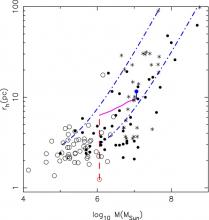
Abstract
In one widely discussed model for the formation of nuclear star clusters (NSCs), massive globular clusters spiral into the center of a galaxy and merge to form the nucleus. It is now known that at least some NSCs coexist with supermassive black holes (SBHs); this is the case, for instance, in the Milky Way (MW). In this paper, we investigate how the presence of a SMBH at the center of the MW impacts the merger hypothesis for the formation of its NSC. Starting from a model consisting of a low-density nuclear stellar disk and the SMBH, we use N-body simulations to follow the successive inspiral and merger of globular clusters. The clusters are started on circular orbits of radius 20 pc, and their initial masses and radii are set up in such a way as to be consistent with the galactic tidal field at that radius. The total accumulated mass by ~10 clusters is about 1.5x107 Solar masses. Each cluster is disrupted by the SMBH at a distance of roughly one parsec. The density profile that results after the final inspiral event is characterized by a core of roughly this radius, and an envelope with density that falls off as 1/r2. These properties are similar to those of the MW NSC, with the exception of the core size, which in the MW is a little smaller. But by continuing the evolution of the model after the final inspiral event, we find that the core shrinks substantially via gravitational encounters in a time (when scaled to the MW) of 10 Gyr as the stellar distribution evolves toward a Bahcall-Wolf cusp. We also show that the luminosity function of the MW NSC is consistent with the hypothesis that a large fraction of the mass comes from (~10 Gyr) old stars, brought in by globular clusters. We conclude that a model in which a large fraction of the mass of the MW NSC arose from infalling globular clusters is consistent with existing observational constraints.